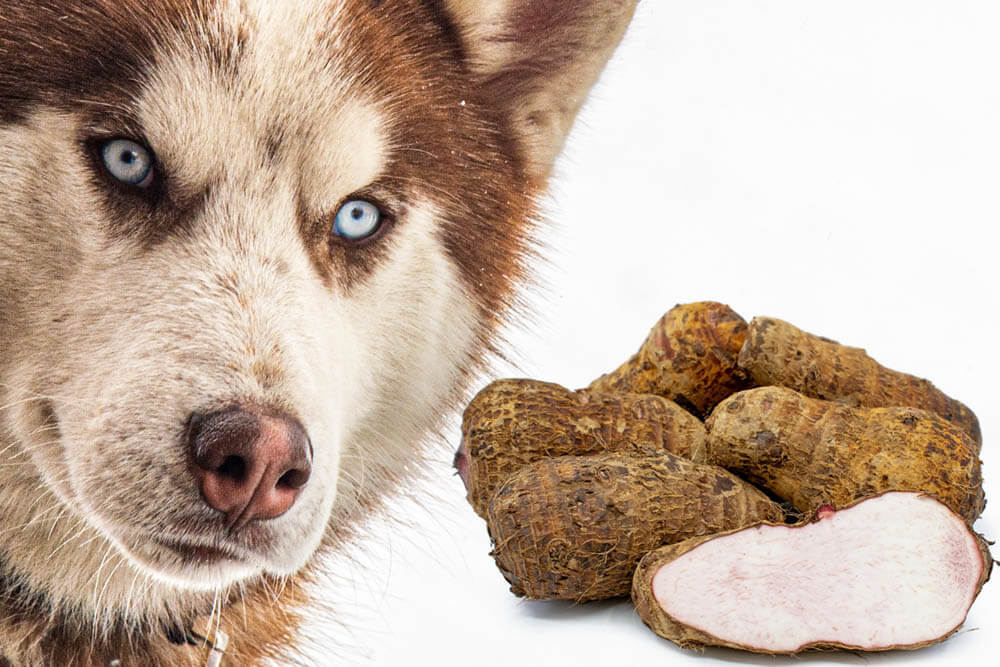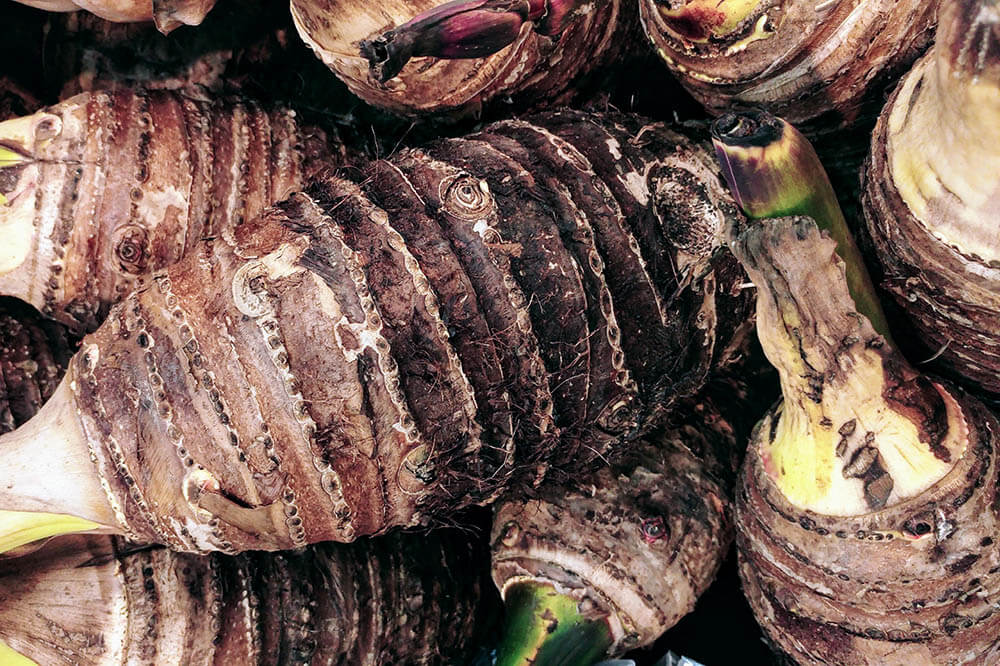A root vegetable of South or Southeast Asian origin, the taro is a popular food all over the world thanks to its sweet, nutty flavor and nutritional goodness.
Dogs benefit from eating veggies, and taros are definitely healthy. So, is it a good idea to feed your pooch taros?
Unfortunately, the answer is no, dogs can’t eat taro. This food may be great for humans, but it’s the complete opposite for dogs.
Let’s get into why taro are bad for dogs!

Is Taro Bad for Dogs?
Yes, both raw and cooked taros are bad for dogs. Every part of the taro, from its heart-shaped leaves to its root (the big, fleshy part we humans eat), can make a dog ill.
The taro plant is bad for dogs because it contains a compound called calcium oxalate, which is toxic to canines. Not to mention its leaves release clusters of needle-like calcium oxalate crystals called raphides, which can puncture your poor doggo’s soft tissues.
A dog that eats taros can end up experiencing any combination of the following problems:
Toxicity
When your dog absorbs the calcium oxalate chemical found in taros, they can experience toxicity, whose symptoms include:
- Diarrhea
- Vomiting
- Abdominal pain
- Cramping
- Difficulty breathing
- Difficulty swallowing
- Excess drooling
- Oral pain and irritation
- Pawing at the mouth
- Whining
- Increase water intake
- Changes in urinary habits
Contact a vet if your dog displays such symptoms after eating taros. Severe symptoms will likely require a trip to the animal clinic or hospital for immediate treatment.

Esophageal or intestinal obstruction
When excited, dogs tend to forgo chewing their food. Unfortunately, swallowing large, hard taro slices can lead to a blockage in the throat or intestines.
The symptoms of throat obstruction include:
- Gagging and retching
- Regurgitation
- Loss of appetite
- Reduced energy
- Excessive drooling
- Depression
- Swallowing difficulty
- Breathing difficulty
- Persistent gulping
- Restlessness
The symptoms of intestinal obstruction include:
- Vomiting
- Diarrhea or difficulty defecating
- Loss of appetite
- Excessive drooling
- Abdominal pain
- Abdominal bloating
- Burping
- Lethargy
- Remaining still
- Refusal to lie down
- Tarry poop
These issues can be life-threatening if not treated quickly. And remember: the smaller the dog, the more likely they are to experience obstruction.
Calcium oxalate stones
Calcium oxalate stones are the second most common type of stones in dogs, and their formation may be linked to the regular consumption of foods high in calcium oxalate. These stones can damage the bladder, kidney, or other parts of the urinary tract, which can kill your dog if left untreated.
When calcium oxalate stones obstruct the urinary tract, the following symptoms can arise:
- Cloudy urine
- Blood in the urine
- Stinky urine
- Frequent urination
- Inability to urinate
- Straining to urinate
- Painful urination
- Vomiting
- Distended abdomen
- Inappropriate elimination
- Loss of appetite
- Depression
- Weakness
Seek help immediately if your dog exhibits the above symptoms. Their life could depend on it.

FAQs About Taro for Dogs
Here, we answer more frequently asked questions about taros for dogs.
My dog ate taro. What should I do?
Start by staying calm. Then, figure out how many taros or taro slices your dog ate.
A few tiny taro slices may not cause any issues. Nevertheless, keep an eye on them for problems such as vomiting, diarrhea, excess drooling, and whining. At any sign of trouble, contact a vet for advice and follow the instructions they give you.
Your dog is likely to experience more significant concerns if they eat an entire taro or multiple taro slices. Contact the vet as soon as you can, explain what happened, describe any symptoms your pet is already exhibiting, and do whatever the vet tells you to do. You may have to rush your pooch to the animal clinic or hospital, especially if the symptoms are severe.
If you can’t reach a vet, those in North America can also call the Pet Poison Helpline at (855) 764-7661 or Animal Poison Control at (888) 426-4435.
My dog is choking on a taro! What should I do?
You need to act fast to help a choking dog. However, you should remember to remain calm.
To help your pet, start by laying them down on their side. Ask someone to gently hold them down so that they don’t move around.
Open your dog’s mouth wide so the back of their throat is visible. If you see the taro stuck in their throat, reach in with tongs, a long tweezer, needle-nose pliers, or your hands, then grab the taro and pull it out. Take great care not to push the taro further down the esophagus.
If you can’t see or reach the taro, you’ll have to perform the Heimlich maneuver.
If you have a small dog, place them on your lap, stomach up. Position your palm just below their ribcage, then gently push upward and inward. Do this 5 times. Next, roll your pooch onto their side and inspect their mouth for the obstruction. Repeat the process until the obstruction is ejected.
The maneuver is different for larger dogs.
If they’re on their side, place one hand on their back and the other on their abdomen. Squeeze or push the abdomen upward and forward toward their spine, then examine their mouth for the taro. Repeat until the blockage is removed.
If the dog is standing, the technique is similar to how the Heimlich maneuver is performed on a human. Wrap your arms around their torso and link your hands into fists below their abdomen. Then, firmly and quickly thrust those fists upward and forward so they push on the abdomen. Do this 5 times, then check your dog’s mouth for the taro. Repeat until the blockage is expelled from the throat.
Whatever technique you use, once the blockage is removed, check the back of your dog’s mouth and remove any additional loose food to prevent further choking.
After you’ve removed the taro from your dog’s throat, contact a veterinarian immediately. Your pet may need to be hospitalized if they spent considerable time without oxygen. Their throat and mouth will also need to be examined for damage.
Can a dog gain any nutritional benefits from eating taros?
Taros do contain nutrients dogs need to stay healthy. For example, they’re rich in potassium, which helps regulate muscle contractions and body fluid as well as transmit nerve signals. They’re extremely fibrous, and fiber keeps the digestive system healthy to prevent issues such as diarrhea and constipation. Taros also boast nutrients such as vitamin A and C, both of which help the immune system stray strong.
Unfortunately, these health benefits don’t mean much when your dog can get extremely ill from eating taros. If you want to feed your dog a nutritious snack, there are far better options, such as eggs, carrots, cucumbers, and Brussels sprouts. These foods will provide your pooch with a range of essential nutrients without compromising their health!
Let taros remain a human food; don’t feed dogs taros!

Conclusion
Taros may be good for human consumption, but they’re a definite no-no for our canine pals. These root vegetables can make your dog ill in various ways, from toxicity that can lead to vomiting and diarrhea to the development of calcium oxalate bladder stones.
So no, your dog can’t eat taro. If you want them to enjoy something healthy, give them something else, like a carrot or a cucumber.
